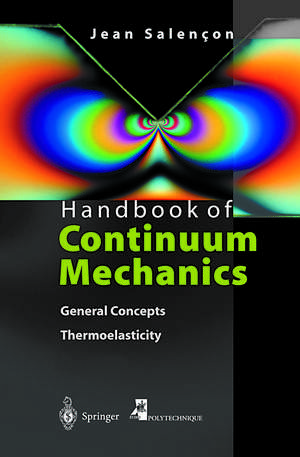Handbook of Continuum Mechanics: General Concepts Thermoelasticity
Autor Jean Salencon Traducere de S. Lyleen Limba Engleză Paperback – 7 dec 2012
Preț: 627.24 lei
Preț vechi: 814.59 lei
-23% Nou
Puncte Express: 941
Preț estimativ în valută:
120.04€ • 124.86$ • 99.10£
120.04€ • 124.86$ • 99.10£
Carte tipărită la comandă
Livrare economică 10-16 aprilie
Preluare comenzi: 021 569.72.76
Specificații
ISBN-13: 9783642625565
ISBN-10: 3642625568
Pagini: 920
Ilustrații: XIX, 804 p. With 1 Falttafel.
Dimensiuni: 155 x 235 x 48 mm
Ediția:Softcover reprint of the original 1st ed. 2001
Editura: Springer Berlin, Heidelberg
Colecția Springer
Locul publicării:Berlin, Heidelberg, Germany
ISBN-10: 3642625568
Pagini: 920
Ilustrații: XIX, 804 p. With 1 Falttafel.
Dimensiuni: 155 x 235 x 48 mm
Ediția:Softcover reprint of the original 1st ed. 2001
Editura: Springer Berlin, Heidelberg
Colecția Springer
Locul publicării:Berlin, Heidelberg, Germany
Public țintă
GraduateCuprins
I. Modelling the Continuum.- II. Deformation.- III. Kinematics.- IV. The Virtual Work Approach to the Modelling of Forces.- V. Modelling Forces in Continuum Mechanics.- VI. Local Analysis of Stresses.- VII. Thermoelasticity.- VIII. Thermoelastic Processes and Equilibrium.- IX. Classic Topics in Three-Dimensional Elasticity.- X. Variational Methods in Linearised Thermoelasticity.- XI. Statics of One-Dimensional Media.- XII. Thermoelastic Structural Analysis.- Appendices.- I. Element of Tensor Calculus.- 1 Tensors on a Vector Space.- 1.1 Definition.- 1.2 First Rank Tensors.- 1.3 Second Rank Tensors.- 2 Tensor Product of Tensors.- 2.1 Definition.- 2.2 Examples.- 2.3 Product Tensors.- 3 Tensor Components.- 3.1 Definition.- 3.2 Change of Basis.- 3.3 Mixed Second Rank Tensors.- 3.4 Twice Contravariant or Twice Covariant Second Rank Tensors.- 3.5 Components of a Tensor Product.- 4 Contraction.- 4.1 Definition of the Contraction of a Tensor.- 4.2 Contracted Multiplication.- 4.3 Doubly Contracted Product of Two Tensors.- 4.4 Total Contraction of a Tensor Product.- 4.5 Defining Tensors by Duality.- 4.6 Invariants of a Mixed Second Rank Tensor.- 5 Tensors on a Euclidean Vector Space.- 5.1 Definition of a Euclidean Space.- 5.2 Application: Deformation in a Linear Mapping.- 5.5 First Rank Euclidean Tensors and the Contracted Product.- 5.6 Second Rank Euclidean Tensors of Simple Product Form and their Contracted Products.- 5.7 Second Rank Euclidean Tensors.- 5.10 Principal Axes and Principal Values of a Real Symmetric Second Rank Euclidean Tensor.- 6 Tensor Fields.- 6.1 Definition.- 6.2 Derivative and Gradient of a Tensor Field.- 6.3 Divergence of a Tensor Field.- 6.4 Curvilinear Coordinates.- Summary of Main Formulas.- II. Differential Operators: Basic Formulas.- 1 Orthonormal Cartesian Coordinates.- 1.1 Coordinates.- 1.2 Vector Field.- 1.3 Scalar Function.- 1.4 Second Rank Tensor Field.- 2 General Cartesian Coordinates.- 2.1 Coordinates.- 2.2 Vector Field.- 2.3 Scalar Function.- 2.4 Second Rank Tensor Field.- 3 Cylindrical Coordinates.- 3.1 Parametrisation.- 3.2 Vector Field.- 3.3 Scalar Function.- 3.4 Symmetric Second Rank Tensor Field.- 4 Spherical Coordinates.- 4.1 Parametrisation.- 4.2 Vector Field.- 4.3 Scalar Function.- 4.4 Symmetric Second Rank Tensor Field.- III. Elements of Plane Elasticity.- 1 Plane Problems.- 2 Plane Strain Thermoelastic Equilibrium.- 2.1 Plane Linearised Strain Tensor.- 2.2 Plane Strain Displacement Field.- 2.3 Plane Strain Thermoelastic Equilibrium in a Homogeneous and Isotropic Material.- 2.4 Solution by the Displacement Method.- 2.5 Solution by the Stress Method.- 2.6 Remarks on the Plane Strain Two-Dimensional Problem.- 2.7 Two-Dimensional Beltrami-Michell Equation.- 2.8 Body Forces Deriving from a Potential. Airy Function.- 2.9 Cylindrical Tube Under Pressure.- 3 Plane Stress Thermoelastic Equilibrium.- 3.1 Plane Stress Tensor.- 3.2 Plane Stress Field.- 3.3 Plane Stress Thermoelastic Equilibrium in a Homogeneous and Isotropic Material.- 3.4 Solution.- 3.5 Cylindrical Tube Under Pressure.- Summary of Main Formulas.
Recenzii
From the reviews of the first edition:
"The book contains an introduction to the fundamental concepts of kinematics, dynamics, and thermodynamics within the context of non-linear field theories. … All in all, the book is an original and inventive introduction into the fundamentals of continuum mechanics … ." (Technische Mechanik, Vol.24 (1), 2004)
"What makes the book different from others is a unified treatment of forces acting on a continuum by using the principle of virtual work as well as an original choice of material presentation including, in particular, problems at the end of each chapter. … In its present form, the handbook could be used world-wide in universities and polytechnic schools as a textbook on continuum mechanics. Those who have been doing research in the field for years, should also find the book useful for teaching purposes." (Jozef Ignaczak, Zentralblatt MATH, Vol. 981, 2002)
"The book contains an introduction to the fundamental concepts of kinematics, dynamics, and thermodynamics within the context of non-linear field theories. … All in all, the book is an original and inventive introduction into the fundamentals of continuum mechanics … ." (Technische Mechanik, Vol.24 (1), 2004)
"What makes the book different from others is a unified treatment of forces acting on a continuum by using the principle of virtual work as well as an original choice of material presentation including, in particular, problems at the end of each chapter. … In its present form, the handbook could be used world-wide in universities and polytechnic schools as a textbook on continuum mechanics. Those who have been doing research in the field for years, should also find the book useful for teaching purposes." (Jozef Ignaczak, Zentralblatt MATH, Vol. 981, 2002)
Textul de pe ultima copertă
This outstanding approach to Continuum Mechanics follows the traditional lectures held at the Ecole Polytechnique. Its highly mathematical level of teaching, together with abstracts, summaries, boxes of essential formulas and numerous exercises with solutions, make the Handbook of Continuum Mechanics the most complete book in this area. Students, lecturers, and practitioners alike will find it a rich source for their studies or daily work. A fold-out glossary and a short reader as a booklet are included.
Caracteristici
Outstanding approach from the Ecole Polytechnique's educational program High mathematical level of teaching The most complete book ever Abstracts, summaries, formula boxes, exercises with solution included Fold-out glossary and short reader included Includes supplementary material: sn.pub/extras
